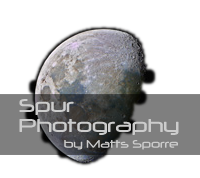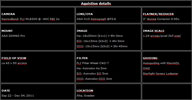NGC 2359 (also known as Thor's Helmet and Sh2-298) is an emission nebula in the constellation Canis Major. The nebula is approximately 15,000 light-years away and 30 light years in size. The central star is the Wolf-Rayet star HD 56925, an extremely hot giant thought to be in a brief, pre-supernova stage of evolution. It is similar in nature to the Bubble Nebula, interactions with a nearby large molecular cloud are thought to have contributed to the more complex shape and curved bow-shock structure of Thor's Helmet.
The above text is taken from Wikipedia.
I have been fortunate to be able to use the remote set-up in Siding Spring - Australia via iTelescope.net. Previously I have taken some luminance images via iTelescope.net and then combined it with color images taken from my home observatory. This is my first fully remote image. iTelescope.net is fairly easy to use and the staff is very professional so I can warmly recommend it should you have the possibility to use their service.
Mouseover of the small thumbnails to the left will show the six different combinations of three narrowband images (Ha, OIII and SII).
Hubble Standard: R = SII, G = Ha, B = OIII. The top-left thumbnail is the familiar Hubble composition where the Ha, OIII and SII images has been adjusted so that they all have similar histograms. In this way the OIII and SII contribution will show up. If this histogram equalization is not done, the image will be dominated by the Ha channel, i.e. it will be green.
Hubble colour shift: The top-middle thumbnail is based on the top-left, to which a colour shift has been applied Photoshop's Selective Color tool (see Bob Frankes tutorial). One has to be very careful when using the Selective Color tool in PS, since it is easy to shift to much resulting in sharp borders between colours.
Hubble modified: The top-right thumbnail is a modification to the Hubble composition (Orange = Ha (hue=35), Red = SII (hue=0), Cyan = OIII (hue=210). Instead of assigning Ha to green I assigned Ha to orange (Hue = 35 in PS notation), SII to red (as in Hubble) and OIII to a slightly more turquoise hue (Hue = 210 in PS notation). This palette has the advantage of separating the different narrowband images (as do the Hubble colour shifting composition), but has the advantage of not being dependent on careful usage of the Selective Color tool.
Artificial RGB: The bottom-left thumbnail is an attempt at mapping the narrowband images to colours (R = 80%Ha + 20%SII, G = OIII, B = 85%OIII + 15%Ha) so that the image would mimic the result of a broadband RGB image. It has been constructed by using the fact that H-beta emission (blue) accompanies the H-alpha line (red) with H-beta roughly 15% of the strength of the H-alpha. To the best of my knowledge this was first suggested by Richard Crisp. It also uses the fact that OIII is positioned in-between the blue and green part of the spectra. A litte bit of SII is added to the red channel.
ARGB redder: the bottom-middle thumbnail is based on the Artificial RGB image but the OIII contribution has been dialled down. Sometimes the ARGB blend above gives white areas where OIII is the strongest. In order to get a more "realistic" RGB representation the OIII contribution to both the blue and the green channel can be turned down to your subjective liking.
ARGB bluer: the bottom-right thumbnail is based on the Artificial RGB image but the OIII contribution to the blue channels has been dialled up. One of the ideas behind the Hubble palette representation is that it visualizes the different contributions Ha, OIII, SII. This can also be achieved in a RGB like representation by dialling up the OIII contribution to the blue channel. In this way the OIII areas will be bluish, the Ha areas will be reddish and the SII areas will be deep red.
In order to make most use of the weak OIII and SII data I have also used JP Metsavainio's Tone Mapping technique. A pdf that outlines tone mapping can be found here, and in order to bring out as much details as possible I have followed some of the tutorials on Ken Crawford's site.
Below you see images for each emission line respectively. The images has been stacked and stretched so that the histogram peak is equal for each of them. Note that all images has been binned 1x1 (unbinned).
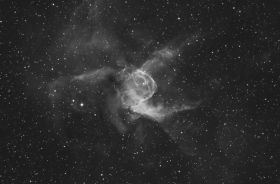
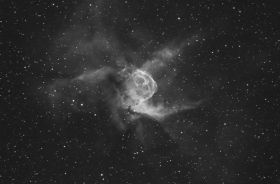
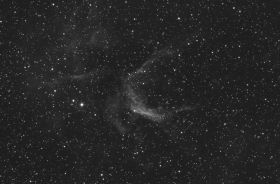
Ha OIII SII
The following software has been used. MaximDL (image acquisition and guiding), CCDStack (calibration and RGB scaling, PixInsight (cropping, background correction, colour corrections) and Photoshop CS5 (all the rest, incl Noel Carbonis Astronomy Tools), and finally JP Metsavainio's Tone Mapping technique.
This image was processed in June 2013

